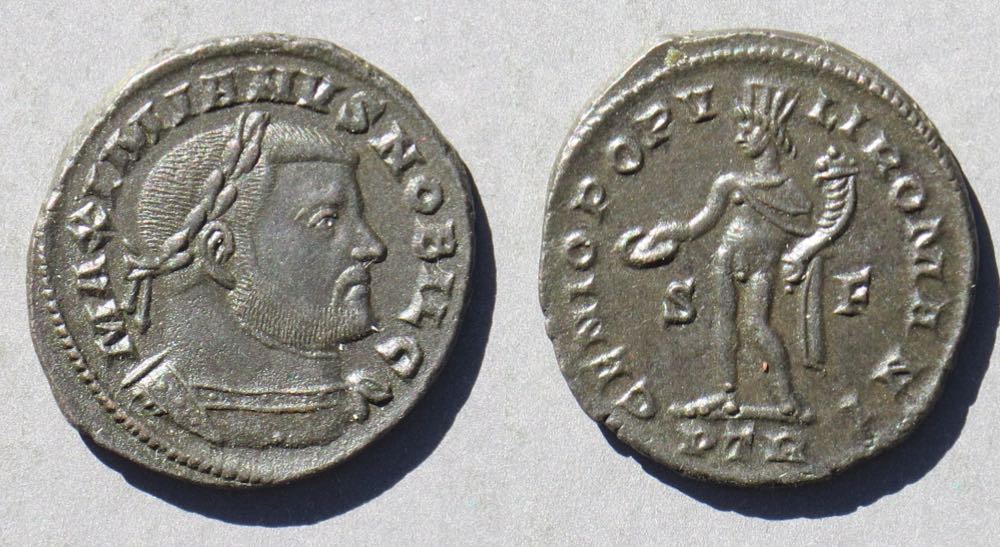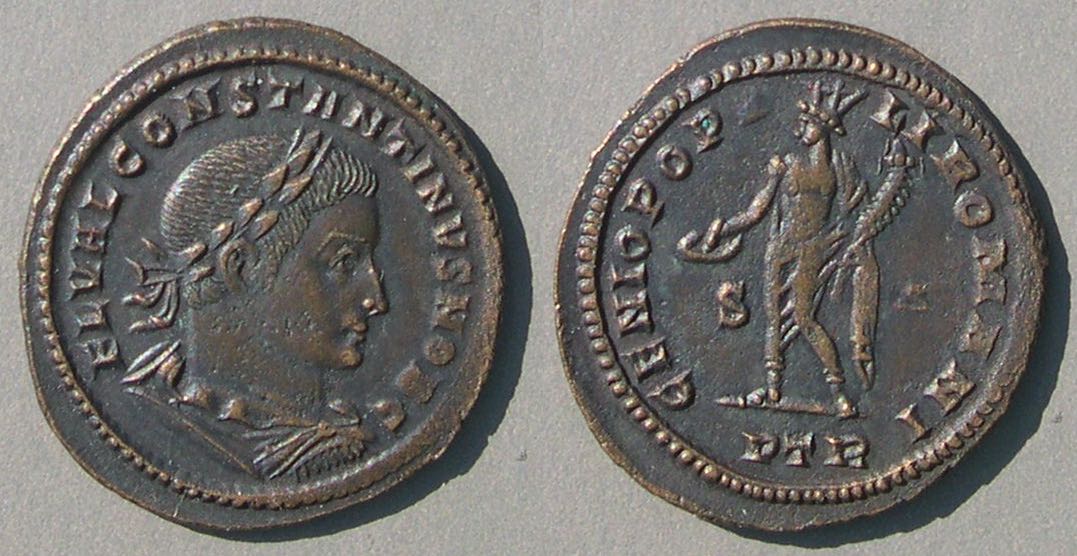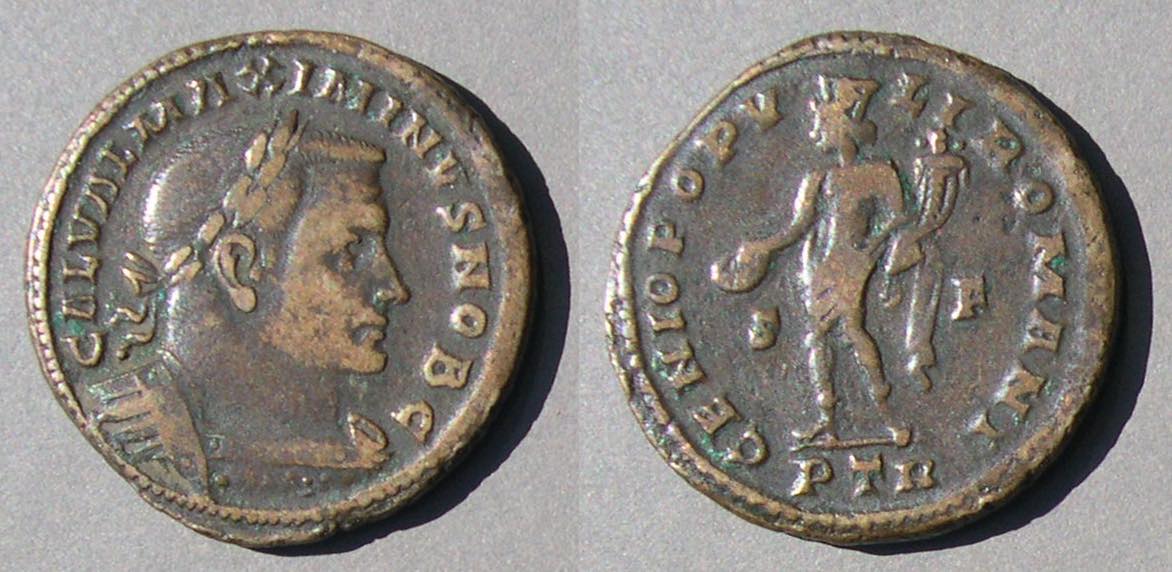How coins are dated to the Second Tetrarchy. [This page has principles of dating. Most readers would rather just see coins. To see coins, skip this theory page and go to the main page about the coins of the Second Tetrarchy.]
The reign of Constantius as Augustus defines the Second Tetrarchy.
Rule 1: Coins of Constantius as Augustus are of the Second Tetrarchy.
Ancient sources say the army proclaimed Constantine emperor when Constantius died. Surely Constantius arranged it or at least would have approved. The coins show Constantine then issued coins as Caesar, not as Augustus. In the tetrarchal system when the position of Augustus became vacant the Caesar Severus would have been promoted to Augustus. But there may have been a short time lag before that happened and during which there were two Caesars in the west.
Rule 2: Coins of Severus II as Caesar are of the Second Tetrarchy, or from so soon thereafter that calling them "Second Tetrarchy" is justified.
The eastern rulers Galerius as Augustus and Maximinus II as Caesar continued with their titles unchanged after the death of Constantius so their coins with those titles are not necessarily from the period of the Second Tetrarchy. In fact, most are not because the Second Tetrarchy lasted only 15 months and they had those titles for 6 years and 5 years, respectively. From the title Augustus alone we could not know that a coin of Galerius was issued during the Second Tetrarchy.
Rule 3: Coins of Galerius as Augustus and Maximinus II as Caesar are not necessarily from the period of the Second Tetrarchy. Some types continued during and after the Second Tetrarchy. For those we use RIC, which has separated coins into "issues" and used detailed anaysis of the mint and control marks to determine which are under the Second Tetrarchy.
Rule 4: Types of Galerius and Maximinus II that are not shared with Second-Tetrarchy collegues are distinctly later and not from the Second Tetrarchy.
 For example, the type GENIO POP ROM is shared at Trier by Galerius as Augustus, Maximinus II as Caesar, and Constantine as Caesar, but not by Severus II as Caesar.
For example, the type GENIO POP ROM is shared at Trier by Galerius as Augustus, Maximinus II as Caesar, and Constantine as Caesar, but not by Severus II as Caesar.
Maximinus II, as Caesar, at Trier.
25 mm. 6.28 grams.
GAL VAL MAXIMINVS NOB C
RIC Trier 720a, "c. Summer 307". Sear IV 14734.
From the title Caesar alone it could be Second Tetrarchy or later. We know it is later because the issue is shared with rulers not in the Second Tetrarchy. GENIO POP ROM is not a Second Tetrarchy type.
By the way, note how much this portrait looks like Constantine. The Trier mint was in Constantine's territory.
Issues. An "issue" is a group of coins presumed to be produced at the same mint and during the same time period because they have the same mint marks (below the ground line on the reverse, i.e. "in exergue") and control marks (in the field) and often the same type, other than different officina numbers and different legends for different rulers.
Mints frequently changed mintmarks and control marks. Sometimes an issue is subdivided by officina number (e.g. A, B, Γ, Δ). Usually a mint changes its types or mintmarks or control-marks or legends when there is a change in instructions to the mint because of a change in the power structure. Usually a type in an issue was issued in the names of all the rulers recognized at the mint (sometimes the type was appropriate just for both Augusti or just for both Caesars). For example, when an issue has Galerius as Augustus with co-ruler Severus II as Augustus, we know the Galerius was not from the time of the Second Tetrarchy because Severus II was Caesar for Second Tetrarchy issues.
 Example. In the case of the Maximinus II coin to the right, the issue is determined by
Example. In the case of the Maximinus II coin to the right, the issue is determined by
• the mint, Siscia,
• the form of the mintmark: SIS<officina number>, and
• the symbol in the field, VI.
It is RIC Siscia 174b unlisted variety (officina B. Only Γ is listed.)
There are coins in that issue at Siscia for Maximinus II (shown), Severus II as Caesar, and Constantine as Caesar. How can that be?
Perhaps it was begun for the two Caesars of the Second Tetrarchy and Constantine was added to it in progress? Another possibility is that the issue did not begin until Constantine became Caesar and was really issued shortly after Constantius died and before Severus II was approved as the new Augustus. RIC dates the CONCORD-IA IMPERI type to "305-307," which acknowledges that the date is uncertain. For that time period at Siscia RIC has 3 different obverse legends for Constantius, 3 for Galerius, 8 for Severus, 5 for Maximinus and only 1 for Constantine. Some day we may have the evidence needed to date the issues more precisely than RIC could.
Also, do not think that precise dates to the nearest day are correct. For example, when Constantius died in July 306, mints (as soon as they became aware of it) naturally stopped minting in his name, changed control marks or mintmarks, and minted in the names and titles of the rulers they regarded as now in power. However, it might take a month for news to travel from Britain (he died at York) to Alexandria and some more time for the mint at Alexandria to react, so if you read a precise date for an issue it must really be treated as only approximate.
Trier. There is a time period dated "1 May 305- early 307" in RIC when Trier issued GENIO POPVLI ROMANI coins for the Second Tetrarchy. Again, there are many different obverse legends-- 4 for Constantius, 4 for Galerius, 8 for Severus II (4 as Caesar and 4 as Augustus), 5 for Maximinus II, and 5 for Constantine as Caesar. If we knew enough to define "issues" more precisely, a change in obverse legend would correspond to a change in issue. Then we would wish to put the issues in chronological order and date them closely.
When Second-Tetrarchy types continue on in an issue with control marks that include coins of Constantine, the issue is later than the issue without Constantine.
At Trier there were two issues of GENIO POPVLI ROMANI with the same mintmark and control marks that are distinguished in an unusual way. Since it was introduced in 294 the type had Genius naked. Then, Genius had loins draped and the legends include Constantine as Caesar. Differences like these affect dating. The next coin is just to illustrate the "naked" Genius that had been issued for over a decade. Then, three coins are from a "loins draped" issue.

Galerius as Caesar under the First Tetrarchy
Trier
28-26 mm. 9.66 grams.
MAXIMIANVS NOBIL C
Genius naked but for chlamys over left shoulder.
S in left field, F in right field (That might abbreviate "Saeculi Felicitas"--happy times.)
PTR in exergue
RIC Trier 594b "c. 303- 1 May 305" (i.e. the last issue before becoming Augustus)
[There is a type just like this but with Galerius as Augustus. The point of this coin is to show what Genius looked like "naked" until the following coins were minted.]
Only the four Second-Tetrarchy rulers participate in the "naked' issue from Trier, so it must be before the next issue with "loins draped" in which Constantine participates.

Severus II as Caesar
27 mm.
FL VAL SEVERVS NOB C
GENIO POPVLI ROMANI, Genius standing left, head with tower, loins draped but for chlamys over left shoulder, holding patera and cornucopia,S in left field, F in right field. (That might abbreviate "Saeculi Felicitas"--happy times.)
PTR in exergue
RIC Trier 651 "1 May 305 - early 307"
Since Severus II is Caesar, this is likely a Second Tetrarchy issue, or at the latest before Severus II became Augustus.
There is a coin from the same issue with Constantine as Caesar. [This is not that coin, but is very similar. Here the field mark is SA, not SF, and the issue is the next one.]

Constantine as Caesar
29-28 mm.
FL VAL CONSTANTINVS NOB C
GENIO POPVLI ROMANI, Genius standing left, head with tower, loins draped but for chlamys over left shoulder, holding patera and cornucopia.
S in left field, A in right field
PTR in exergue
RIC Trier 694 "c. Spring 307"
Maybe Constantine was added to the issue in progress. Otherwise, we would expect the issue to have Severus II as Augustus. Actually, the RIC group does. Among the eight obverse legends for Severus II, four are as Augustus. We just don't have enough evidence to subdivide the one RIC group more finely yet. Yes, we know the Severus II as Augustus coins are later, but we don't know which of the Galerius and Maximinus coins in that group go with Severus II as Augustus and which as Caesar (more abou this below).
That makes the date of the next coin uncertain.
Maximinus II was Caesar from May 305 until early 309 when he became Augustus. Rule 3 above says his coins as Caesar may or may not be issued during the Second Tetrarchy. So, what do we make of this coin that is from the same group in RIC as the Severus as Caesar? Well, that group includes Severus as Augustus, too. If we knew more we would divide the "issue" more finely using obverse legends. But we don't yet know how to tell which Maximinus II coins go with Severus II as Caesar and which go with him as Augustus.

Maximinus II as Caesar
27 mm.
GAL VAL MAXIMINVS NOB C
GENIO POPVLI ROMANI, Genius standing left, head with tower, loins draped but for chlamys over left shoulder, holding patera and cornucopia.
S in left field, F in right field.
PTR in exergue
RIC Trier 667b "1 May 305 - early 307"
This coin with "loins draped" is from a second part of that time period in which five rulers, including Constantine participate. Maybe the elevation of Constantine was enough to change the presentation of Genius and this type is later than the Second Tetrarchy. Or, maybe the issue was in progress when Constantine was elevated and he joined it late. We don't yet know. There is lots of research to be done!
More about issues. Ideally, an issue would have only one obverse legend for each ruler. Surely there was some reason for changing the obverse legends, and it seems likely they changed at the same time. Consider Siscia. From 305 to 307 Severus II has 8 different obverse legends including
FLA VAL SEVERVS NOB CAES and FLA VAL SEVERVS NOB C and FL VAL SEVERVS NOB C. Maximinus II has exactly parallel legends
GAL VAL MAXIMINVS NOB CAES and GAL VAL MAXIMINVS NOB C and GA VAL MAXIMINVS NOB C
It seems likely they would be paired in the same "issue," but subdividing the groups in RIC and putting them in order remains to be done. One principle is that usually legends begin long with more names and become shorter as time progresses.
Comment for Collectors. Ancient coins are fun to collect. They give you lots to think about besides just the grade and worth. There are lots of interesting questions that remain unanswered and lots of details that make a significant difference. It is quite possible to find a new variety that helps answer some question and nevertheless buy the coin with little or no premium.
Return to the page on the coins of the Second Tetrarchy.
 For example, the type GENIO POP ROM is shared at Trier by Galerius as Augustus, Maximinus II as Caesar, and Constantine as Caesar, but not by Severus II as Caesar.
For example, the type GENIO POP ROM is shared at Trier by Galerius as Augustus, Maximinus II as Caesar, and Constantine as Caesar, but not by Severus II as Caesar.  Example. In the case of the Maximinus II coin to the right, the issue is determined by
Example. In the case of the Maximinus II coin to the right, the issue is determined by 


